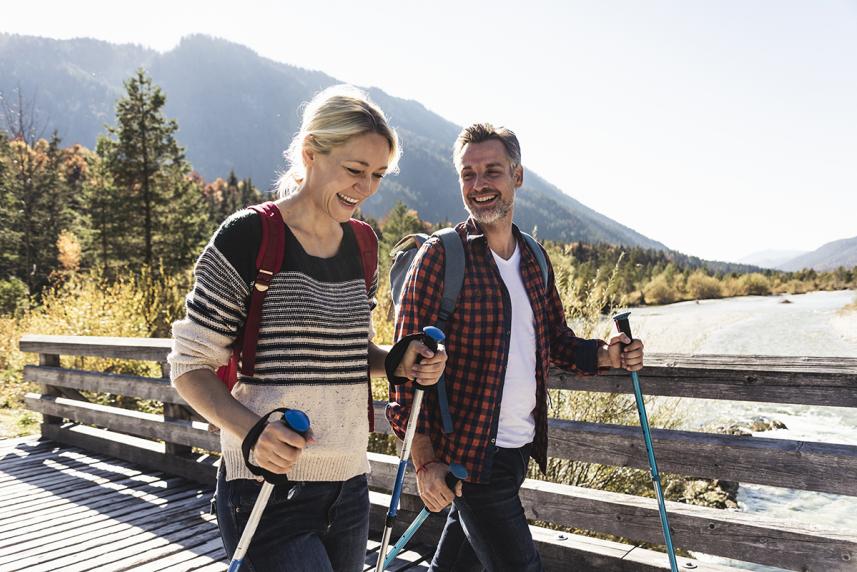
We have you covered — schedule a virtual visit today. No insurance required.

Yes, you read that right. Learn how getting your steps in helps, plus other ways to ease knee pain.
You know that creaky feeling you get in your knees when you play tennis or play with your kids? Or when you bend down to pick something up? You could have knee osteoarthritis (OA).
This is a joint disease that often happens from repeated wear and tear. It’s the most common type of arthritis in the U.S., and it occurs more often in older people.
In fact, around 13% of women and 10% of men 60 and older have knee pain from osteoarthritis, according to the National Library of Medicine.
Do you live with knee OA? You’ve probably tried lots of treatments, from ice packs to pain relievers. But have you tried lacing up your sneakers and heading out for a walk? It turns out walking is one of the best ways to ease knee pain.
Here’s what you need to know.
A recent study found that walking reduces knee pain in both men and women over 50. And it can help prevent pain and damage to the knees, even if you haven’t developed OA.
Walking is good for knee pain because it strengthens the leg muscles that support the knees, says Richard M. Bochner, MD. He’s an orthopedic surgeon at Northwell Health Physician Partners in Great Neck, New York. “Also, knee motion helps to lubricate the lining cartilage of the knee,” he says.
When you don’t use your knees, they get weak, stiff and painful.
The Optum Store provides total care for your body and mind. Refill medications, schedule a virtual visit or shop for OTC pain medications all from the comfort of home. Start exploring.
Be sure to wear good sneakers and stay hydrated with water.
If your knees hurt after a walk, try icing them, says Farah Hameed, MD. She’s a rehabilitation and regenerative medicine specialist at Columbia University Medical Center in New York City.
Stretching after exercise can also reduce the risk of knee pain, she adds. Whether you opt to walk on a treadmill or outdoors is up to you. But older people may want to avoid trails.
“Trail walking means uneven ground, and that can cause knee problems such as sprains and more wear and tear,” says Savan D. Patel, MD. He’s an orthopedic surgeon at Northwestern Medicine Huntley Hospital in Huntley, Illinois.
Walking isn’t the only way to prevent knee pain. Here are some other things to try.
Maintain a healthy weight. If you’re overweight, try to get down to a healthy size. “When you lose weight, it takes the pressure off your knees,” says Gens Goodman, DO. He’s an orthopedic surgeon at Banner-University Medical Center of Tucson. This means less knee pain.
Try over-the-counter medications. Acetaminophen (Tylenol⊃), ibuprofen (Advil⊃) and naproxen (Aleve⊃) can help relieve pain. Check with your doctor to see which is best for you.
Choose topical remedies. There are several pain relievers you put directly on your skin that may help. Lidocaine patches or ointment can numb a painful area. “Salicylate-based treatments such as lidocaine can also reduce pain by decreasing swelling and inflammation,” says Dr. Hameed.
You might try pain relievers that have menthol/camphor. They reduce swelling — as well as localized pain — by warming or cooling the skin.
Using a CBD ointment could help as well. There’s some evidence that it may reduce pain and inflammation in animals. Just be sure to buy CBD ointment from a reputable source.
A final option: An anti-inflammatory medication such as Voltaren gel.
Apply heat and ice. Applying warm or cool compresses can do wonders for all sorts of body pain. “Ice is good, especially if the joint is swollen,” Dr. Hameed says. “Heat also can be helpful around the muscles of the knee joint.”
Go to physical therapy. This type of treatment can straighten the knee joint. That means the knee doesn’t get injured as easily. And it helps to maintain joint cartilage.
Pick the right form of exercise for you. If you have knee OA, avoid high-impact exercises such as running. “As you develop arthritis later in life, running seems to exacerbate it,” says Dr. Goodman.
And keep in mind that walking isn’t the only form of exercise that can help you feel better. “Some patients find it painful,” Dr. Hameed says. If that sounds like you, try non-weight-bearing exercises such as cycling or swimming.

We have you covered — schedule a virtual visit today. No insurance required.
Additional sources
Statistics on OA: National Library of Medicine (2022). “Knee Osteoarthritis”
Walking study: Arthritis & Rheumatology (2022). “Association Between Walking for Exercise and Symptomatic and Structural Progression in Individuals with Knee Osteoarthritis: Data from the Osteoarthritis Initiative Cohort”